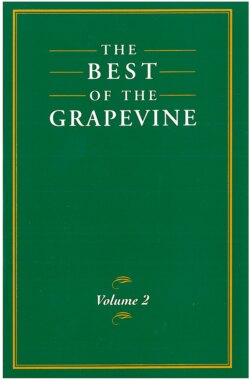Читать книгу The Best of Grapevine, Vols. 1,2,3 - Группа авторов - Страница 57
На сайте Литреса книга снята с продажи.
Promises, Promises
ОглавлениеMay 1981
I love the so-called promises in the paragraph that begins at bottom of page 83 and continues at the top of page 84 of the Big Book. I frequently quote one or another of them. I often mention them in an AA qualification.
That’s why I was pleased recently to receive a scroll containing “The Promises,’’ inscribed in beautiful calligraphy, as a souvenir of an AA dinner I attended. And then, as I admired the scroll, it set me to thinking. We are certainly hearing more about “The Promises” these days. I’ve seen them printed in AA newsletters and bulletins and AA convention programs. I’ve heard members ask, “Why doesn’t AA offer ‘The Promises’ as a wall plaque like the Steps and the Traditions? And maybe on a wallet card?”
Is this a trend in our Fellowship—this lifting the promises out of context and inscribing them in bronze? Are we sanctifying the promises?
If so, it troubles me. I view such a trend with alarm. Why?
Because, first of all, if we go back to the source and read the paragraph of the Big Book containing the promises, it is immediately clear that they were not intended to be set apart. They are not written as a separate element as are the Steps (page 59) or the Traditions (beginning page 564).
They are buried in the text (and within the context), and for a reason: They are part of a discussion of how to work the Steps. Not even all the Steps, really, but specifically the first nine. The paragraph in question follows a long description of the mess our alcoholic lives are in and advice on how to work our way out.
Second, these are not unconditional promises as they seem to be when set apart. Quite the contrary. They are a spontaneous, almost euphoric expression of the experiences of the authors with the rewards that can be expected “if we are painstaking about this phase of our development.’’ What phase? The working of the first nine Steps as described in the preceding twenty-four pages!
And how many of us have actually worked the Steps that way? How many of us, for example, in doing our Fourth Step inventory, have followed the example in the Big Book?—a written “grudge list” in three separate columns, analyzing the causes of each resentment and how it affects us. Not I. How many of us took Steps Eight and Nine with the diligence and thoroughness recommended in detail from page 76 to page 83 in the Big Book? Not I. Yet we must recognize that that is what is meant by being “painstaking.”
What the Big Book is saying on page 83 is that if we have bared our souls, if we have completely reconstructed our shattered relationships with others, then we “are going to know a new freedom…,” then “we will not regret the past,” and so on through the rest of the promises. In fact it says “they will always materialize if we work for them” (the italics are mine). And the rest of that chapter is devoted to telling us how to continue to work for them by practicing Steps Ten and Eleven.
Finally, it seems to me that when I quote the promises so glibly and smugly (as I am inclined to do), I may actually be playing down the Steps. Am I glorifying end results while ignoring the footwork necessary to get there? Is it easier and more comforting to take refuge in the promises (lifting them out of context, of course) than to go through the purging and the pain of taking the first nine Steps—which are clearly the prerequisites of the promises? The alcoholic seizes upon the promises, consciously or unconsciously, as “an easier, softer way.”
So let’s read and reread Chapters Five and Six (along with the rest of the Big Book, naturally!). And when we get to the beautiful section on pages 83 and 84, let’s cherish the promised rewards set forth there. Let’s carry them in our minds and hearts as a joyous and inspiring part of our program of recovery.
But let’s not sanctify the promises.
R. P., Riverside, Conn.
